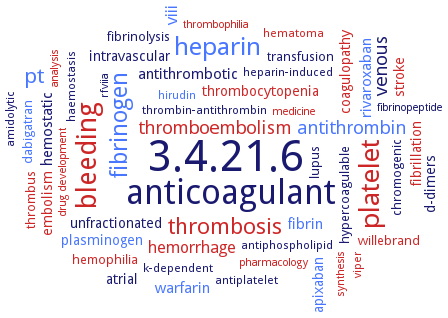Please wait a moment until all data is loaded. This message will disappear when all data is loaded.
Please wait a moment until the data is sorted. This message will disappear when the data is sorted.
D322N/S419A
-
no proteolytic activity
D70K
-
mutation of E2FXa mutant, loss of ability to bind Ca2+, activity is retained
E14D
-
E14 is posttranslationally carboxylated in wild-type enzyme. Heparin activated inhibition of mutant enzyme by antithrombin with and without Ca2+ is enhanced compared to wild-type recombinant FXa
E16D
-
E16 is posttranslationally carboxylated in wild-type enzyme. Heparin activated inhibition of mutant enzyme by antithrombin is not activated by Ca2+
E19D
-
E19 is posttranslationally carboxylated in wild-type enzyme. Heparin activated inhibition of mutant enzyme by antithrombin is the same as wild-type recombinant FXa
E217A
-
affinity for interaction with Na+ is impaired. 3-4fold decrease in activity towards both natural and synthetic substrates. Presence of factor Va restores most of the catalytic defect with substrate prothrombin
E217Q
-
affinity for interaction with Na+ is impaired. Presence of factor Va restores most of the catalytic defect with substrate prothrombin
E26D
-
E26 is posttranslationally carboxylated in wild-type enzyme. Heparin activated inhibition of mutant enzyme by antithrombin is not activated by Ca2+
E29D
-
E29D is posttranslationally carboxylated in wild-type enzyme. Heparin activated inhibition by antithrombin with and without Ca2+ is enhanced compared to wild-type recombinant FXa
E80K
-
mutation of E2FXa mutant, loss of ability to bind Ca2+, activity is retained
F174A
-
the mutant has about wild type activity
F174N
-
site-directed mutagenesis, reduced binding of inhibitor trimethylphenylammonium
G114R
simulation of the exchange of residues, conserved residue in the EGF2 domain sulfide loop, disruptive salt bridge interaction or blockage of interaction with factors VIIIa/IXa
G11V
-
naturally occuring mutation of factor Xa within the omega-loop of the gamma-carboxyglutamic-rich domain of the ature enzyme, leading to enzyme deficiency and a bleeding phenotype, overview. The mutant factor Xa activity is below 1% of wild-type activity, activation with RVV-X is 4fold less effective in the patient's plasma than in healthy plasma. The patient's phenotype appears to be due to a very low rate of FXG11V activation by TF/FVIIa and FVIIIa/FIXa complexes rather than to FXaG11V activity within prothrombinase, overview
G323S
simulation of the exchange of residues, mutation disrupts a highly conserved beta-sheet structure
I16L
-
mutation disrupts activation process of the factor X zymogen with alteration of active site function and impairment of Na+ and factor Va binding. Irreversible stabilization with L-Glu-Gly-L-Arg-chloromethyl ketone fully rescues factor Va binding. The Km value for prothrombin conversion for the mutant assembled into prothrombinase is unaltered, whereas the kcat is reduced 3- to 4fold
K147A
-
site-directed mutagenesis, reduced Km, reduced kcat compared to the wild-type enzyme for the synthetic substrate and for prothrombin as a substrate
L224A
-
affinity for interaction with Na+ is impaired
N57T
simulation of the exchange of residues, loss of interaction with Cys81 with structural implications
P343S
simulation of the exchange of residues, conserved residue involved in a suface beta-sheet, affects intrinsic folding
R143A
-
site-directed mutagenesis, reduced Km, reduced kcat compared to the wild-type enzyme for the synthetic substrate and for prothrombin as a substrate
R154A
-
site-directed mutagenesis, increased Km, increased kcat for the synthetic substrate, and reduced Km and kcat for prothrombin as a substrate compared to the wild-type enzyme
R221A
-
affinity for interaction with Na+ is impaired
R326C
simulation of the exchange of residues, surface residue, involved in protein-protein interactions, interaction with Gln376 located in the S1-binding site
S195A
-
catalytically inactive mutant, that still binds to inhibitor antithrombin with the same velocity as the wild-type enzyme
T318M
simulation of the exchange of residues, surface residue involved in a side-chain hydrogen bond with Glu341 which is lost in the mutant, leads to clinical effect
V17A
-
mutation disrupts activation process of the factor X zymogen with alteration of active site function and impairment of Na+ and factor Va binding. The Km value for prothrombin conversion for the mutant assembled into prothrombinase is unaltered, whereas the kcat is reduced 3- to 4fold
V298M
simulation of the exchange of residues, unfolding occurs due to space limitation
Y225P
-
mutation of the GDFXa mutant, exchange of the Na+ binding site residue results in 2fold decreased stimulation by Na+ in presence or absence of Ca2+
Y99A
-
the enzyme shows strongly reduced activity compared to the wild type enzyme
Y99A/F174A
-
the enzyme shows severely reduced activity compared to the wild type enzyme
Y99T
-
site-directed mutagenesis, 25fold reduced binding of inhibitor trimethylphenylammonium
S135A
-
site-directed mutagenesis, unaltered activity compared to the wild-type enzyme
S425A
-
site-directed mutagenesis, unaltered activity compared to the wild-type enzyme
S89A
-
site-directed mutagenesis, completely inactive mutant
R150A

-
site-directed mutagenesis, reduced Km, reduced kcat compared to the wild-type enzyme for the synthetic substrate and for prothrombin as a substrate
R150A
-
modification of the complementary exosite residue that interacts with the antithrombin exosite. Mutant shows a marked attenuation of the exosite-dependent enhancement of the alpha1-proteinase inhibitor reaction
additional information

-
the enzyme from which the residues 1-44 of the light chain have been removed by chymotryptic proteolysis is indistinguishable from the native enzyme in its activity on benzoyl-Ile-Glu-Gly-Arg-p-nitroanilide, on prothrombin alone, and on prothrombin plus factor Va
additional information
-
construction of factor Xa-trypsin hybrids, display on phage for selection of a mutant with domain architecture of trypsin and specificity of factor Xa
additional information
-
mutant GDFXa shows reduced ability to differentiate between the metal ions bound and reduced amidolyic activity
additional information
-
mutation of factor Va in the prothrombinase enzyme complex consisting of factor Xa and factor Va. The C-terminal region of factor Va heavy chain is crucial for coordinated prothrombin activation by prothrombinase
additional information
-
expression of several differently truncated enzymes reveal that residues 285-335 are critical for prothrombinase activity, a truncated enzyme lacking these residues is catalytically inactive




 results (
results ( results (
results ( top
top






